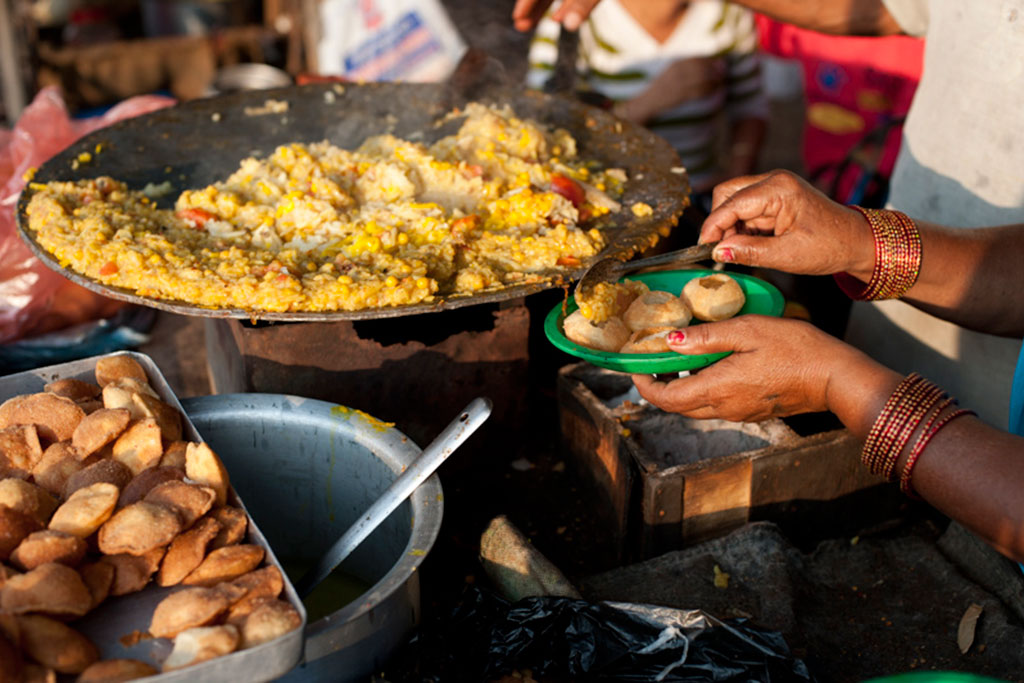Local Nepalese Dishes
The favorite dish of Nepal is Dal Bhat. Nepalis eat it daily – often twice a day. It is served on a steel platter and is similar to Indian thali. In the middle of the platter, you will find steamed rice and a bowl of dal (dried beans and peas). That is surrounded by a lentil soup, curried mixed vegetables and a spicy sauce (achar) made with chilis and spices. It may be paired with bowls of chicken or lamb in restaurants.

While trekking, I love fried eggs for breakfast and momos for lunch. For dinner, dal bhat is the best trekking meal for me. Nepal's national dish is a pile of steaming rice with dal (lentil soup to pour over the rice) and lightly curried seasonal vegetables. In the lower country, it might come with a tomato achaar, whereas at higher elevations with pickled sour vegetables. It is also healthy and dal with rice combines to be a complete protein meal.
The locals pour the warm dal over the rice, then add the veggies and spicy sauce. They knead the mixture into small balls with the right hand before pushing it into their mouth with the thumb. If you prefer to eat less like a local, you can eat each food separately or mix them all with a spoon.
Momo is another popular dish in Nepal. Said to have originated from Tibetan travelers, momos look like small Chinese dumplings. Made with a white-flour dough, momos are filled with chicken, vegetables or buffalo meat, then steamed. The dumplings are often paired with a pickled sauce for dipping. In the areas close to Tibet, the mountain country, you will find momos are moon-shaped and often fried.

Gluten-Free Dining
With its extensive use of rice, lentils, chickpeas and corn, Nepal is a culinary haven for gluten-free dieters. Wealthier Nepalis and tourists can opt for dishes that feature poultry and lamb. Those protein sources are luxuries in this Hindu country where cows are sacred, making beef and veal dishes rare.
Chat with a local specialist who can help organize your trip.
Asan Market

It’s easy to lose yourself in the narrow streets and alleys of Kathmandu’s Asan market. Six streets converge on Asan, home to this traditional Asian bazaar. Asan straddles one of the two legendary India-Tibet trade routes that pass through Kathmandu. You can find just about anything in this bustling marketplace, from kitchenware and tea pots to women’s clothes and jewelry. Since ancient times, the area has been populated with small shops and stalls filled with spices, herbs, molasses, teas, pickles, nuts and even beaten rice.
It is a delight for the eyes and the nose. You’ll smell the earthiness of cumin and coriander, the the sweetness of molasses, the pungent scent of freshly roasted peanuts. Spend some time deciding what you want to buy, then be ready to bargain for better prices, and always bring plenty of rupees, the local currency.
Interested in local Nepali cooking classes? Start your day shopping for fresh ingredients at the local market before returning to the kitchen to cook your favourite dish with the help of a Nepali Chef.
Newari Cuisine
The Newars, an indigenous ethnic group, are known for their unique cuisine that is claimed to feature 200 dishes. Be sure to check out:
- Chatamari, a flat crepe made with rice flour and topped with vegetables, yak cheese, eggs and ground meat.
- Baji (bahee) a dish made with beaten rice that looks like rolled oats served with vegetables and spicy sauce. This is the Newari version of Dal Bhat.
- Choyila (choyeela), a dish with fried buffalo meat mixed with greens.
But most of all, Newari cuisine is known for peculiar dishes made from animal body parts not normally used in Western cuisine. You will find dishes made with tongue, spine, bone marrow and lungs. Don’t be put off by the body parts. These dishes are delicious.
An interesting snack paired with tea is the Yomari (yomaree) which is offered in festivals to thank the gods for the good harvest. Shaped as a pointed fig fruit and steamed, the Yomari is made with a rice-flour dough and filled with sugarcane molasses, ground sesame seeds and coconut.
The Newar are the original people of the Kathmandu Valley, best known for their amazing arts and crafts and great trading skills, but also for their food which is certainly unique and very tasty. If you are a meat lover, and really love every part of the beasts, you can feast on spicy tung, brain and lungs at any Newari restaurant, served with beaten rice and strong rice wine. Vegetarians can also enjoy Newari food and can order lentil baras, bamboo shoot curry, Newari pizza called chatamari and fried soybeans with ginger and garlic. A great Newari restaurant with garden is Bhumi on Lazimpath (almost opposite Hotel Shangdi-la).
Drinks
In Newari areas of the Kathmandu Valley, the most popular drinks are the Chhaang (chang) a rice beer, and Aylā (aeela) made from distilled rice and cereals. Raski, found in Kathmandu, is similar to tequila or sake and is made from distilled rice or millet. Tongba is made from fermented millet. It is served in a jug with a straw and a flask of hot water: you pour the water in, let it steep, and suck the brew through the straw until you reach the bottom.
What You Should Know
Generally speaking, street food is safe. An easy way to judge is to watch and see if the hawker is busy and locals are buying from him. You will find roasted nuts, fruits and other savory and sweet snacks in most areas and cities.

Generally, it is not safe to drink water from the tap. Bottled water is safe, easy to find and cheap. Often at restaurants and hotels, warm water is offered. Before drinking hot beverages like tea and coffee, be sure the water was boiled.
